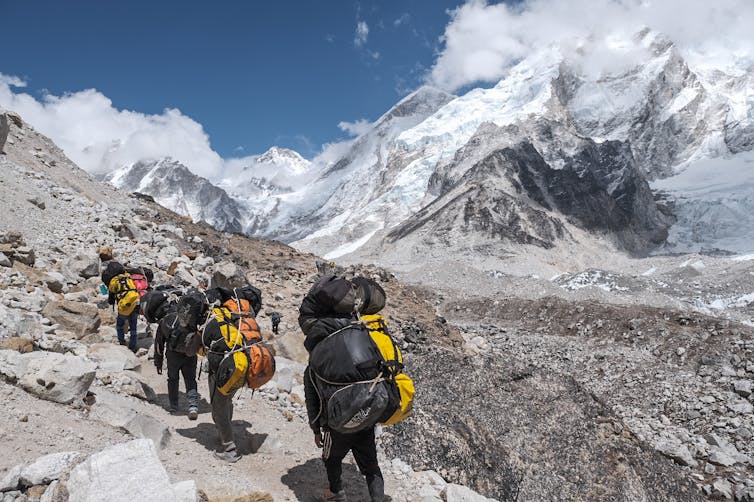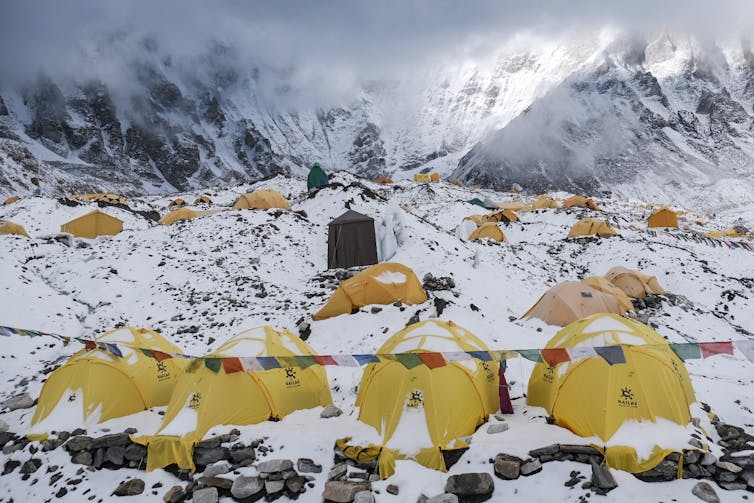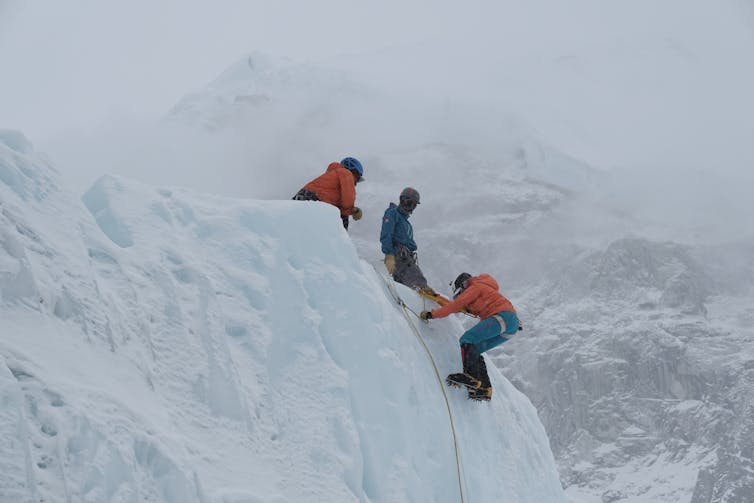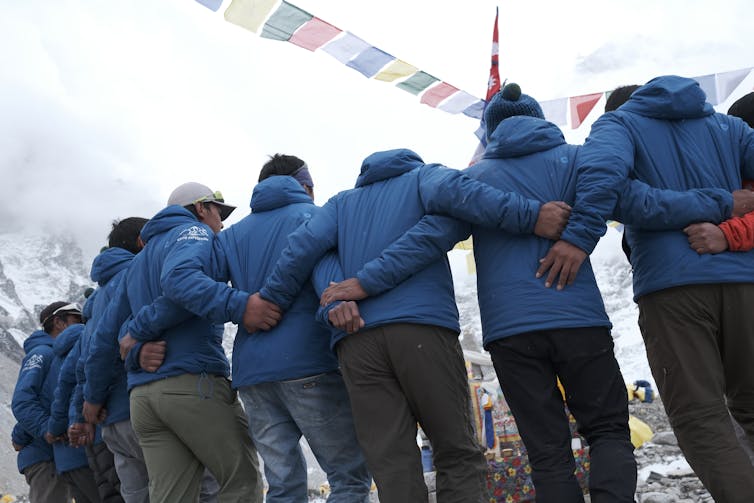Everest: I interviewed people risking their lives in the ‘death zone’ during one of the deadliest seasons yet

Jase Wilson, Leeds Beckett University; Dorina-Maria Buda, Leeds Beckett University, and Elisa Burrai, Leeds Beckett University
Climbing some of the world’s tallest mountains, you enter the “death zone” when you are 8,000 metres from sea level – where oxygen is 34% the concentration it is on the ground below. Climbing here is one of the most dangerous forms of tourism there is. For mountaineers, the most tantalising goal is to climb the world’s 14 highest peaks, all of which stretch into the death zone.
They’re all in Central Asia and are indeed the deadliest. The biggest, Mount Everest, is 8,848 metres tall and straddles Nepal and China. K2 in Pakistan and China is the second tallest at 8,611 metres, while Kangchenjunga (8,586 metres) and Lhotse (8,516 metres) in Nepal, aren’t far behind. Some seasons on mountains like K2 can see death rates of 32% for those attempting the summit.
Read more: Everest: 11 climbers dead in 16 days – how should we deal with the bodies on the mountain?
We usually think of holidays as a chance to enjoy life, but with the bodies of fallen climbers clearly visible on Mount Everest, death is always present in the tourism industry here. In this way, high-altitude mountaineering can be considered a form of dark tourism – when people pay to travel to sites of death, disaster or atrocity.
I’m a doctoral researcher in tourism studies who was stationed for six weeks between April and May 2019 at the Everest Base Camp. There, I interviewed tourists, high-altitude workers and all the people who kept the death zone economy moving and all those who were poised for the summit.

Encounters in the death zone
On May 14 2019, the first climbers of the season reached the summit of Mount Everest. Below at 5300 metres, many more were waiting to acclimatise to the thin air in base camp. I arrived there in mid-April, just as climbers were beginning to acclimatise – exposing their bodies to an altitude which causes the body to produce extra red blood cells so they can carry more oxygen.
By mid-May, climbers at the base camp had been anxiously waiting for over five weeks for the weather to abate, allowing Nepali workers to go to the summit in advance to fix ropes to the side of the mountain so that other climbers can follow safely. In 2018, the window period – when 70-80mph jet stream winds suddenly lull – lasted 11 days, allowing climbers to spread out over many days. In 2019, there had been only five days of low winds by May 23. This meant most climbers had to crowd into climbing the summit in fewer days.

I spoke with two climbers hoping to become the first Greek women to complete the “Seven Summits” – climbing the highest mountain on each continent, one of the most popular challenges in mountaineering. I also met the first Lebanese woman aiming to complete the same challenge. I interviewed the first Romanian woman to try Everest in 2017, but she had to turn around due to tragic complications. In 2019, however, she became the first Romanian woman to climb Lhotse – the world’s fourth highest peak.
Many of the climbers had mementos from those they loved – the ashes of a friend, or the mountaineering axe of a fallen comrade. The moments of waiting and anticipating the summit were the most tense. Each contemplated how years spent saving, training and dreaming would soon be put to the test. The people in base camp anxiously chewed their nails and fidgeted while waiting for their “weather window” to open.
Some had their trips cut short before they could realise their dreams. Altitude sickness, a fall into a crevasse, even fatal accidents from some unpredictable error. All of this played out during the 2019 season even before the summit push, which is always the most dangerous period as this is when climbers enter the death zone. Most climb without serious incident, but every year there are those who don’t make it home.

I came here to understand why people travel from all over the world to risk their lives in the death zone. A tourism authority granted them permission to climb and they paid a tourism agency to assist them, but to them, it doesn’t feel like tourism. It feels like something much more – an obsession, a passion, a reason to continue going on in the world.
Who and what they desire to be is all bundled up in this “tourist experience”. Some find the word to be an insult – that one of the most important moments of their lives could be boiled down to something so frivolous. Tourism certainly does fall short in describing the complex emotions and ambitions of those who explore the highest mountains in the world.
Maybe it’s the view of the enormous triangular projection of Everest’s shadow drowning the landscape below as the sun rises over the Tibetan Plateau that is so compelling. The sense of being small on something so enormous, the sensation of being as close to the nothingness of space as one can be on Earth. Maybe it’s to prove to oneself that “I can”, or that “I as a Lebanese woman can”, or that an amputee “can”.
More than 65 years after the feat was first accomplished, climbing Everest remains perhaps the greatest challenge a person can attempt. Since tourism has opened the experience up to more and more people, the promise of personal and public achievement on the roof of the world has proved hard to resist for many. For some, it’s worth risking everything.
Jase Wilson, PhD Researcher in Tourism Studies, Leeds Beckett University; Dorina-Maria Buda, Professor of Tourism Management, Leeds Beckett University, and Elisa Burrai, Senior Lecturer in Tourism and International Development, Leeds Beckett University
This article is republished from The Conversation under a Creative Commons license. Read the original article.




















